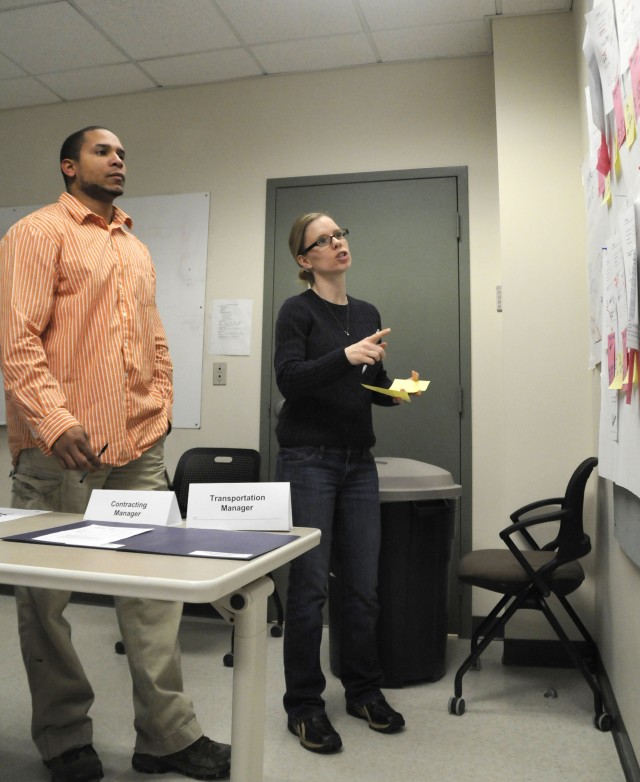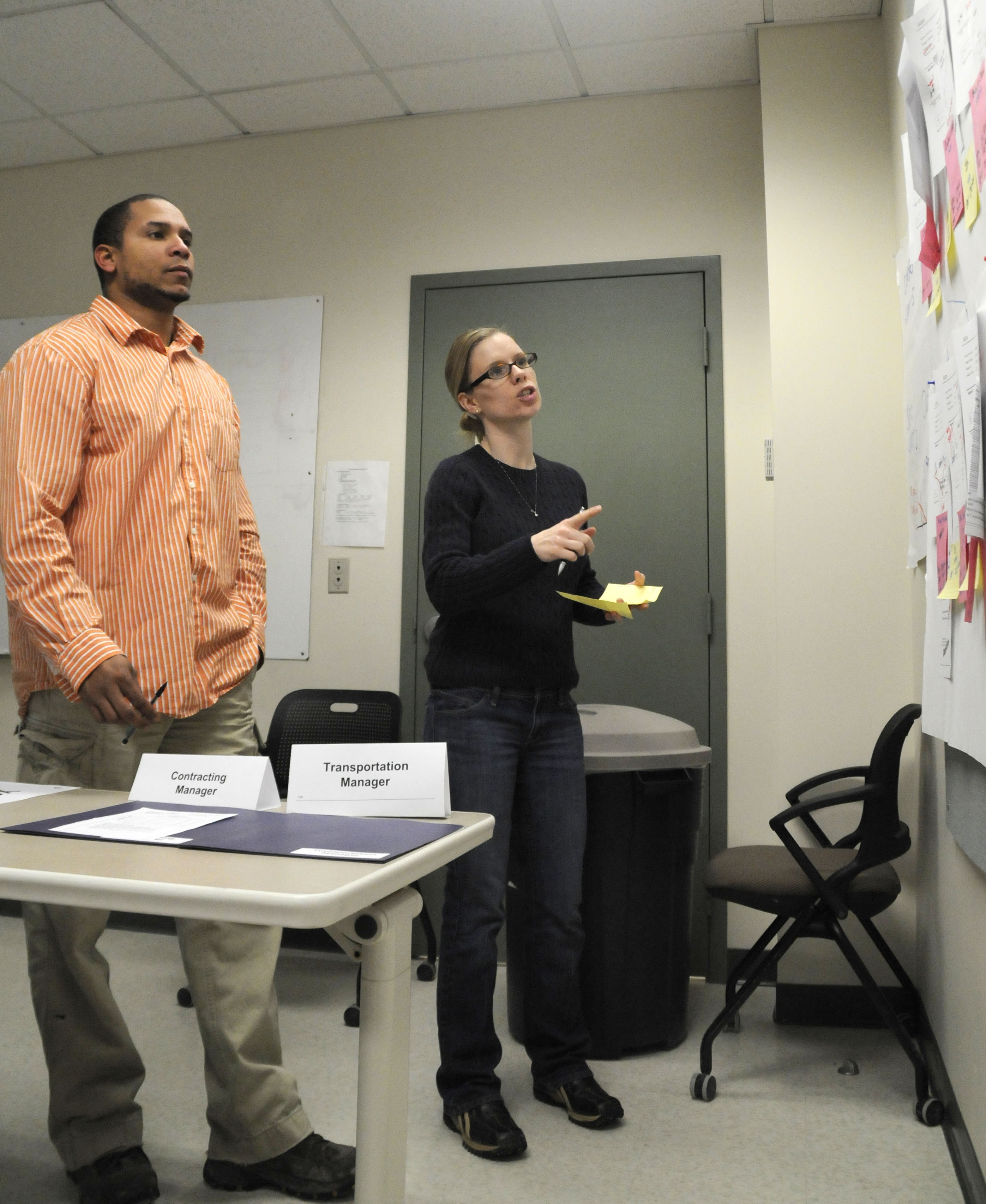
FORT DRUM, NY -- In September, 10th Mountain Division (LI) employees began working on four Lean Six Sigma projects, in hopes that they would earn their green belts and help the Army save money.
At that time, U.S. Army Forces Command stood up a steering committee, composed of Fort Drum staff leads. Committee members received basic LSS training and went through a project identification and selection workshop where they created a project portfolio containing a list of nine potential Fort Drum projects. Projects were prioritized, based on research of operational effectiveness, cost-savings and quality improvement.
After undergoing a "very robust" process, the committee emerged with four projects considered to be high value, explained Jim Bowie, LSS master black belt for JBR Resources and project lead for FORSCOM.
Two things were considered when Chris Munn, Fort Drum chief of staff / Mission Support Element director and green belt training deployment manager, pushed to get the green belt training capability here. The first was to figure out how to turn legacy processes into those more aligned with the Army Forces Generation processes, and the second was to use process improvement to "do more with less."
Champions, who are the people who "own" a process, and green belt candidates, who are the subject-matter experts, were assigned to the projects, and they began the first phase of the five-phase project. The phases are define, measure, analyze, improve and control.
Last week, green belt candidates finished the second half of the two-week LSS training, which was a basic orientation for the green belt candidates. During the first week, March 7 to 11, candidates learned about Sigma levels, which are a way of gauging performance based on defects, statistics and control charts.
Bowie said the candidates were prepared for the first week.
"They were engaged, and at the end of the week they had each formulated new questions, which is exactly what you want them to do, concerning their projects and concerning Lean Six Sigma itself," he noted.
Candidates also began a basic budget simulation that concluded last week. During the simulation, candidates analyzed a process and suggested changes to improve it. The purpose of the simulation is to present a process complex enough that the candidates can use as the basis for learning, which will help candidates work through their own projects.
"A process is a process, whether I'm putting a car together, filing a claim, getting my kids ready for church; it's all a process," Bowie said. "All these (simulation) tools do is help document, analyze and improve that process."
"Without a live, interactive experience, you can't demonstrate the value of the tools, hence the simulation," explained Kenneth Graham, director of FORSCOM's Efficiencies Division's Process Improvement Branch. Graham and Steven Sawicki, deputy director of the branch, served as course instructors.
There are three types of financial benefits in the Army: revenue generation, cost-savings and cost-avoidance.
Each Fort Drum project focuses on a cost-avoidance benefit, which Bowie explained is the "most popular and prevalent in an organization when your budget is controlled well above your level."
The first project spotlights the Government Travel Credit Card Delinquency Rate Reduction, which estimates an annual return on investment of about $59,000. The champion handling project is Luann Smith, MSE G8, and the green belt candidate, Stephanie Sherwood, is a program analyst in the Travel Card / Defense Travel System office.
Fort Drum's GTCC delinquency rate has not met the 2 percent Department of the Army standard delinquency rate in at least the last two years. The goal of Sherwood's project is to reduce the number of delinquencies and meet the delinquency rate.
Bowie anticipated results for Sherwood's project by the end of June, which he noted is "relatively quick."
The next project, Excess Inventory (Class II and IX) Reduction, targets surplus inventory and how to eliminate ordering too much. Class II inventory is clothing, individual equipment and office supplies, and Class IX is repair parts and components for major end items. The champion handling project is John Williams, MSE G4, and the green belt candidate is Quatrell Walker, logistic management specialist in the Logistics Management Supply and Services Section.
In Fiscal Year 2010, the 10th Mountain Division (LI) turned in $3.3 million of serviceable excess inventory to FORSCOM, so the goal of Walker's project is to reduce excess inventory levels by 50 percent, with an estimated return on investment of $1.7 million.
Walker said since going through the training, he is now able to define and get to the root of the problem. Now in the measure phase, he is gathering data to identify where excess is generated.
The third project, Exchange Pricing Delta Bill Reduction, focuses on turnaround time from when a unit receives a new part to when they hand in the old or defective part.
Units receive their new part for half the price if they turn in the old or broken one within 60 days of receiving the new part.
Williams is championing the project and the green belt candidate is Ralph Deafenbaugh, logistics management specialist in MSE G4.
Deafenbaugh said before the class, he identified a problem, looked at it and determined the solution based on what he saw. Now, he said, LSS has taught him to look at the problem and use the steps in the five processes to get to the source of the problem.
Bowie said there is a constant trend across FORCOM where old parts are not being turned in within the 60-day window, so units are being charged the full amount for the new part. The project is planned to be completed by July, with an estimated ROI of about $4 million.
The fourth project, Non-Deployable Soldier Cycle Time Reduction, is designed to cut down on the time that Soldiers are considered unable to deploy. Per 12- to 15-month deployment, the division has an average of 1,055 nondeployable Soldiers, which costs about $93 million. The goal is to reduce out-processing lead time and costs by 50 percent, with an estimated annual ROI of $46 million.
The project is championed by Maj. Ellen Hey, and the green belt candidate is Laura Swatsworth, MSE, Medical Operations / Patient Administrative Division, with the Division SurgeonAca,!a,,cs Office.
"When we fix it here, we'll be able to take our solution and go over to (Fort) Riley and say 'here.' It' won't be exact, but it will be really close," Graham explained, noting this process is also known as "best practice."
The projects began before the class started, so the candidates could target savings.
"They did their homework, (which) enabled them to readily apply the academic information against the practical," Bowie noted.
To obtain their green belts, candidates must complete their project and pass an exam, which was administered Friday. All of the candidates passed their exams.
"Across all of Forces Command, 10th Mountain is heads and tails above all the other units as far as the savings we are targeting right now. We're leading the way dramatically," Bowie explained.
He also said the timing is appropriate because of budget constraints, and through LSS, they're hoping to increase the mission load without increasing resources.
"We're always in the business of improving processes and problem-solving," Munn noted, adding that the training moves fast and gives them an opportunity to "deep-dive" into some of the systems, as well as apply methodical process.
"If this results in doing more with less and aligning some of our legacy linear systems with ARFORGEN, then I think we want to go for more (training)," he added.
"We would not have the green belt training (here) if we did not have the senior leadership support," said Bowie, who said he believes people will be coming to Fort Drum to learn the division's best practices.
"Part of the FORSCOM campaign plan is to create a cost-awareness culture. These tools have applications, not just in working projects, but some of these tools are used in part of the operations (and) part of the decision-making process, (in order) to be more cost-effective and provide a more quality product for the customer," Graham said.

Social Sharing